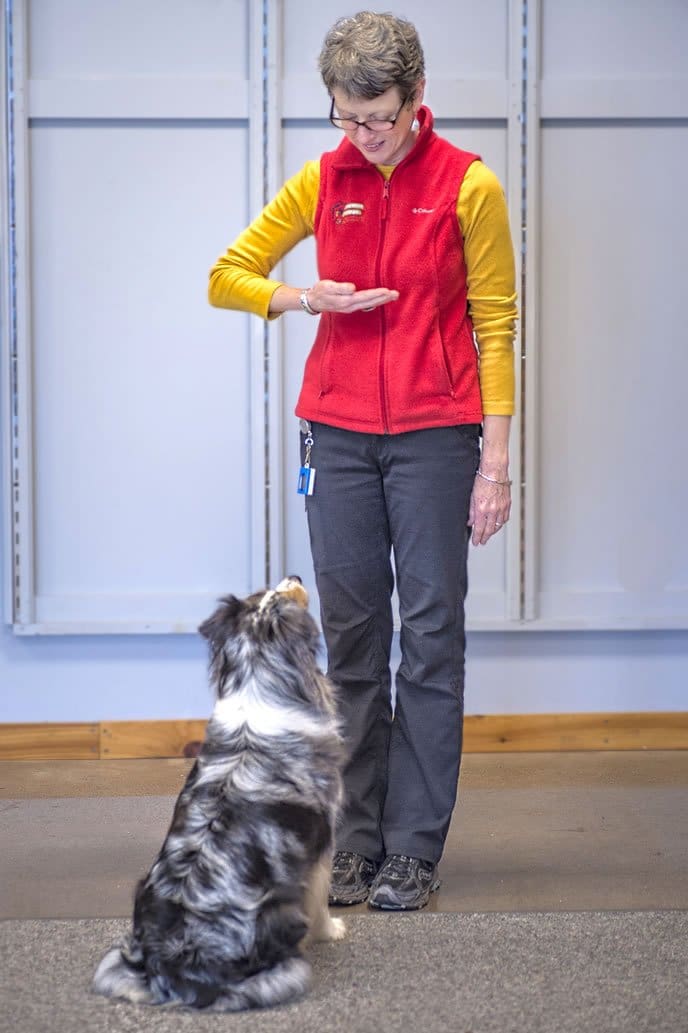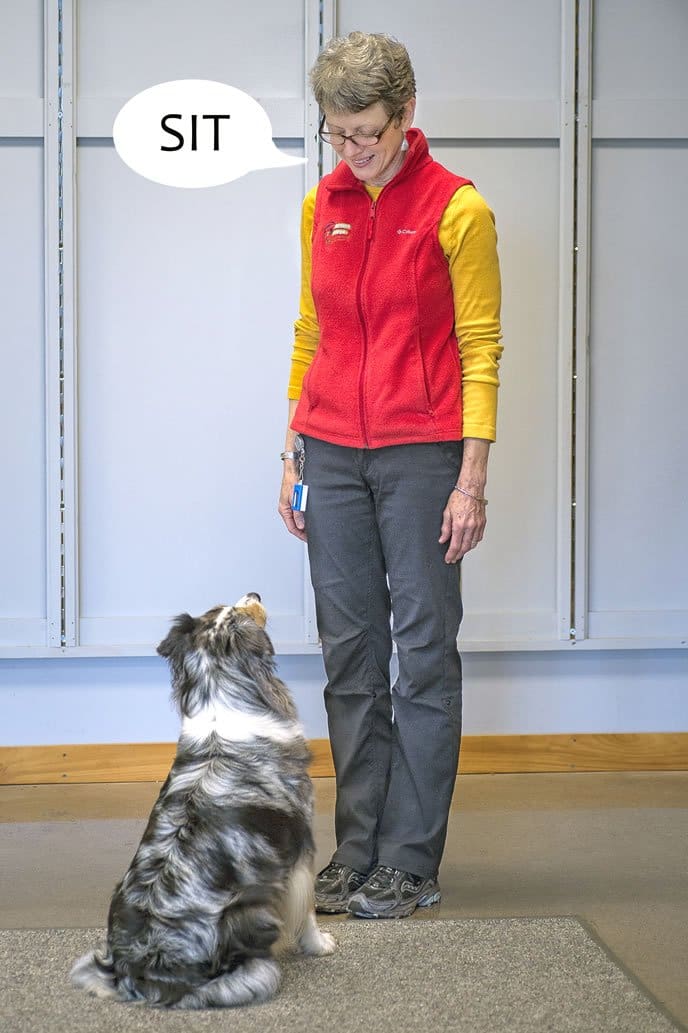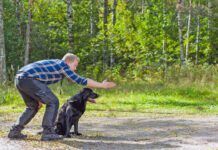It’s important to know what your cues are for your dog. Yes, I bet you think you know, but in reality your dog may think your cues are very different than what you think they are.

Photos by Bonita Ash
As a professional trainer, I’m pretty good at adding cues that are clear to me and clear for the dog. However, I’ve recently had a bit more time to work with my own dog, Willow, a 3-year-old Australian Shepherd. It’s been a blast teaching her a few new tricks, adding humorous cues to those behaviors and even changing some cues to a few tricks she’s already learned. But I’ve seen that puzzled look on her face a few times, as if she’s saying, “Hey, Mom, I just don’t get it. Can you be more clear?” I guess it’s time to clean up my cues.

ashfordstudio.com
What IS a cue?
From the handler’s perspective, a cue is the word or action we attach to a specific behavior the animal has learned so that we can elicit that behavior again. In the dog-friendly and humane training I use (and hope you use, too), the word “cue” is used instead of “command.” Command implies “You do it or else!” In the world of positive training, if the dog doesn’t respond to my cue, it’s my job as the trainer to assess what just occurred and tweak my own actions to help the dog succeed. If the dog succeeds, the dog earns reinforcement, and reinforcement makes the behavior more likely to happen again.
In reality, a cue is anything your dog can perceive. It’s also a chance to earn reinforcement. Our dogs see, hear, smell, touch, and taste, just as we do, so anything a dog is able to perceive by one of her senses can be turned into a cue. In the pet dog world, most people use verbal cues, with hand signals coming in a close second. In canine sports and service dog work, handlers may use a number of other types of cues, including olfactory cues.
Know your ABC’s?
Keep in mind the ABC’s: Antecedent. Behavior. Consequence.
It’s important to understand that the cue (an antecedent) isn’t what causes the behavior to happen. The consequence of the behavior is what makes the specific behavior more likely to increase or decrease. If you like that specific behavior (the sit, down, etc.) and want your dog to do it again, reinforce the heck out of it! Reinforcement drives behavior.
How to add a cue
If you want to teach your dog a new behavior, you must first “show” the dog what to do and make sure the behavior is reliable before adding a cue.
For example, if I’m attempting to teach a dog to sit, I would help to elicit the behavior by first luring, capturing, or shaping the movement. Our dogs know how to sit, right? They just don’t know how to sit when we say “sit.”
To lure the dog into a sit, hold a piece of food in your hand, place it at the dog’s nose and move it up and back over the dog’s head. This causes the dog to look up, rock back a bit, and as she does so, her bottom goes down. When the dog’s bottom hits the floor, you’d mark the desired behavior with the click of a clicker (or a verbal marker, such as the word “Yes!”) and give the dog a yummy piece of food.
To capture a sit, merely wait patiently and observe the dog. When the dog happens to move into the sit position, click/treat.
To shape a sit, consider all the tiny parts of the entire sit position (looking up, rocking back, rear end begins to move closer to the floor), and reinforce each of those tiny parts toward the final behavior of sitting.
Once the dog is reliably (at least 80 to 90 percent of the time) performing the behavior, you can begin to incorporate whatever cue you wish by using your desired cue as the dog performs the behavior.
After the dog is successful a few times, use the cue before the dog performs the behavior. Example: Say “Sit!” (always in a happy tone of voice). Pause one second, and then lure the dog into the sit position. By pausing, you’re giving the dog an opportunity to associate the sound of your verbal cue, “Sit!,” with the behavior of sitting.
Pay close attention to your dog when you say the cue; if you see even the slightest movement that gives you an indication she’s about to sit, praise her (Good girl!) and lure her the rest of the way into the sit position, then click/treat. By encouraging even her slightest movements, you can help increase her response to the verbal cue. With each successive repetition, slowly fade out the lure, and voila!, your dog will respond to your verbal “Sit!” cue.
How to change or add an additional cue
Dogs can learn multiple cues for a single behavior. I have three different cues for Willow’s sit: a verbal cue (an auditory cue I can use if my hands are busy); a hand signal (a visual cue I can use if I’m talking); and the sight of car keys (another visual cue I trained just for the fun of it). I must continue to use and reinforce each cue periodically if I want Willow’s response to these cues to be reliable.
If you want to change a cue, use the “new” cue, pause, then give the “known” cue, and click/treat the correct response. Repeat several times. Next, give the new cue, pause a little bit longer, give the known cue, then click/treat the desired behavior. This gives the dog time to associate the new cue with the old cue.
As you continue to repeat this exercise, before long, your dog will hear the new cue and move into the desired behavior before you have a chance to give the known cue. You’ll be excited so don’t forget to click and treat! Good job! You’ve just changed a cue.
Every dog learns at a different rate, just as we each do. I’ve seen dogs who can learn a new cue in as few as three or four clicks and others take longer. If you’re doing a good job of minimizing your own body language, it will help your dog achieve success in a shorter amount of time.
Confusing our dogs
So often in training, when a dog doesn’t perform the desired behavior in response to the given cue, we blame the dog. I often hear, “He’s blowing me off!” or “She’s being stubborn!” In reality, the handler just didn’t make it clear enough for the dog to fully understand what the person was trying to teach. Here are ways we confuse our dogs:
Expecting our dogs to auto-matically know our language. Dogs don’t come with an English software package installed. We must patiently teach them our language, one cue at a time.
Not taking the time to define the cue’s goal behavior. Have in mind the specific definition of what you expect. I suggest you create a cue dictionary. Write down every cue you currently use, then define the goal behavior for each cue. Do you want a straight sit with square hips or a sidesaddle sit? A speedy down or a slow down? Defining your cues and the goal behavior for each in writing will help you be clear in your own mind about what you expect, and that will make it more clear for your dog.
Check out the cue dictionary that my colleague, Sarah Foster of Cold Nose College Atlanta, put together for her dog, Jane (see page 7).
Adding cues too early. It’s important to teach your dog the behavior and make sure she can perform it reliably before adding the cue.
Using two cues simultaneouslY. For example, a verbal cue and a body cue (hand signal): Dogs are keen observers. They pick up on our body language before they pick up on our words. If you use a verbal cue, but also a body movement with it (such as the word “sit” and then the hand signal for “sit”), I’d bet that if you said the word and didn’t use the body movement, the dog probably wouldn’t understand what you meant and might not give you the behavior you expect.
POOR REINFORCEMENT. Don’t fail to reinforce the newly learned behavior enough for it to become fluent. Some dogs catch on very quickly; others more slowly, but they all can learn if we’re patient and reinforce the desired behavior appropriately.
Choosing cues that look similar or sound similaR. Choosing the verbal cues such as Down and Bow for two different behaviors can be confusing for your dog. Instead of Bow, I suggest Bravo or TaDa!
There are other reasons a dog doesn’t respond to a cue: the dog didn’t see or hear the cue; the dog didn’t recognize the cue because it’s too similar to another cue; the dog was distracted by the environment (another dog, person, squirrel); the dog felt unsafe.
So, repeat after me: “Don’t blame the dog.” Take a look at your training techniques and find a way to tweak the process so you can help your dog be successful. When your dog is successful, she earns reinforcement and that behavior you worked diligently to install and put on cue works perfectly. The result is clear communication with your favorite furry friend. Happy dog. Happy trainer!





